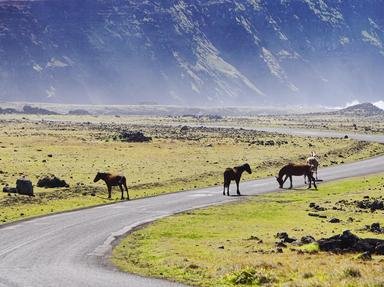Quiz Answer Key and Fun Facts
1. Punta Arenas is a port city in Patagonia, in South America. It is in mainland Chile, and lies on the southern coast, far away from any other large towns or cities. On what body of water does Punta Arenas have a coastline?
2. The ozone hole over Punta Arenas gets larger and smaller in cycles, meaning that the ozone layer is thinner in October than in any other month.
3. Picture yourself in Punta Arenas. The sky is white, but it is still the same temperature as it was yesterday. The sunlight is incredibly bright, almost blinding, and it reflects off of cars and the sea. Is this a red light day (when there is almost no ozone over Punta Arenas), an orange light (when the ozone is getting dangerously thin), a yellow light day (when the ozone is thinner than usual), or a green light day (when the ozone coverage is normal)?
4. Because of the hole in the ozone layer, there is a high rate of skin cancer in Punta Arenas. How much higher is the chance of getting cancer in Punta Arenas compared to anywhere else in the world?
5. Even though the sun emits UV rays, there is still a large demand for another source of UV light in Punta Arenas. What amenity that also emits UV are we talking about?
6. When the hole in the ozone is directly above Punta Arenas, an area of Antarctica is also badly affected. Which area of Antarctica is worst affected when the ozone hole is in this position?
7. Punta Arenas, although a large city, was not always a settlement. In fact, it was built in 1848 to make sure that Chile got a share of the land that is known as Patagonia (and therefore retain an important trade route). What country did Chile compete with to keep this land?
8. On a trip outside in Punta Arenas, tourists (as well as the locals) are advised to wear sunscreen to ward off the damaging UV light. What is the minimum factor of sunscreen people are advised to use while in Punta Arenas?
9. The ozone hole covers a large area of Antarctica and Patagonia, as we have discussed in previous questions. The hole has been estimated at 26,000,000 (26 million) square kilometres in size. This is about the same size as which continent?
10. Ozone thickness is measured in Dobson Units, where 0.01mm equals one Dobson Units. Ozone levels in the rest of the world are usually around 400 Dobson Units, or 4mm thick, but how thin has the ozone layer over Punta Arenas been known to go?
Source: Author
Flynn_17
This quiz was reviewed by FunTrivia editor
minch before going online.
Any errors found in FunTrivia content are routinely corrected through our feedback system.
